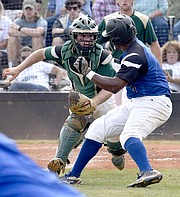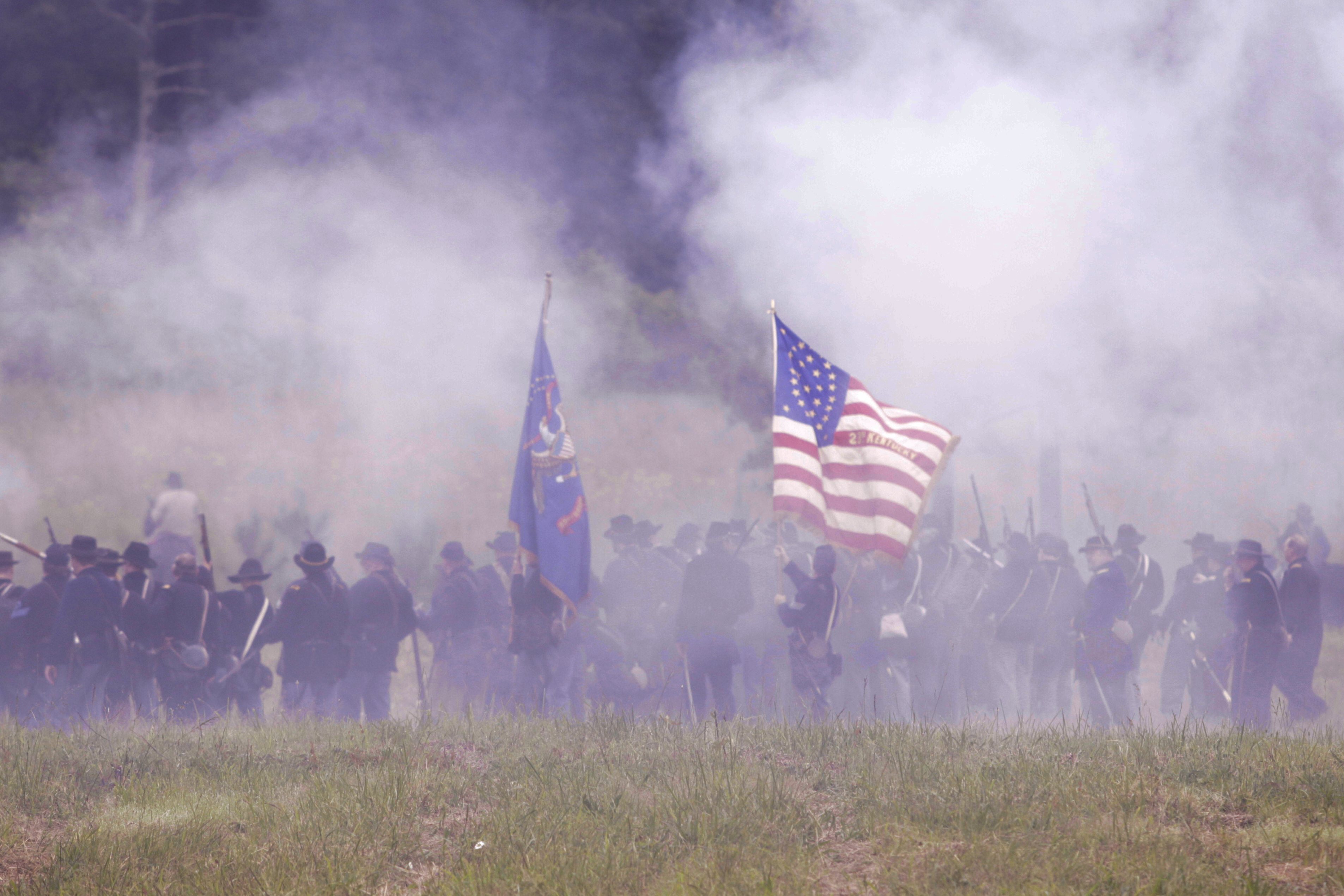RESACA, Ga. - Events surrounding the Battle of Resaca, Ga., re-enactment began Saturday not with cannon fire but with a prayer.
Less than half a mile south of the site of the battle, in a manmade clearing inside a grove of poplar, oak and dogwood trees, men and women stood near a stone cross and circles of gravestones.
In a few hours they would all take their places in the replica Civil War encampment and ensuing battle. But for a few moments they remembered the men who died on that field 149 years ago, and the woman who performed the unenviable task of giving those men a respectable resting place.
Saturday's re-enactment signals the end of major 149th anniversary events in the Chattanooga area. Long-awaited sesquicentennial, or 150th anniversary, events kick off with the Tullahoma campaign in late June.
After a prayer and three rifle volleys, after the words from descendants of Confederate and Union soldiers, Jule Medders spoke briefly about Miss Mary J. Green and then sang her a song.
"It wasn't a pretty job," Medders said. "There's nothing pretty about digging up dead people."
Resaca's Confederate Cemetery holds the bodies of more than 450 Confederate soldiers who died just north in the two-day battle.
It was Green who dug up bodies hastily buried on the battlefield and hauled them to the cemetery site. The first, wooden grave markers later burned or rotted, said James Lay, president of the Gordon County Historical Society.
After the Confederate Army was defeated at Chattanooga in November 1863, many of the troops retreated to Dalton, Ga., for the winter. By May the following year, Union Maj. Gen. William T. Sherman began his march to Atlanta from Chattanooga with more than 100,000 troops.
Portions of that force had skirmishes with Rebels near Resaca on May 13, and the full battle began the next day.
•••
Frank Benson, now 94, was at the first battle re-enactment in 1964 on the fight's 100th anniversary. He stood in his uniform of a Confederate lieutenant general and steadied himself with a wooden cane.
In 1964 a ragtag bunch of men in blue jeans, carrying their hunting shotguns, collided on the field to honor their ancestors and local history.
There was a gap in re-enactments and no one present Saturday was certain when they were taken up again. But since they did, Benson was sure he'd been at nearly all of them.
"I missed one. I had a heart attack," he said.
Later, at the battle site, re-enactors from across Georgia and Tennessee and a few from Florida and South Carolina wore period garb and prepared for combat.
Others stood beside tables full of period curiosities and relics of a bygone era.
Dixon Grubbs, 54, got into the re-enactment lifestyle just three years ago. He knew from the start he didn't want to be on the battlefield, though.
"I was in the real Army for four years," Grubbs said. "I kind of had my stomach full of taking orders."
Instead, he wears a bloody apron and hovers over a bone saw, amputation kit and various implements of the 1860s medical profession.
He's not the only person walking the wet ground who won't be fighting but still plays an integral role in the day's performance.
An hour before the battle is scheduled to begin Dixie Weader, 22, of Charleston, S.C., steps along the tents selling wares to spectators. She's wearing a maroon and black day dress she made herself, complete with embroidered black, fingerless gloves, common to the era.
She's found a close-knit group of people scattered by geography at these events.
Weader can ride sidesaddle and plans to do so at the upcoming 150th anniversary of the Battle of Chickamauga.
One slightly anachronistic item is the pink tongue piercing that flicks into view when she talks. Sometimes she doesn't take it out.
•••
The battle re-enactment opens at 2 p.m., with more than 300 spectators atop the hill overlooking the rolling field below.
A slight drizzle begins, dampening the scene.
Confederate Brig. Gen. Ken Padgett, commanding the Georgia Division Reenactors Association, surveys the field with his binoculars, a cigar clenched in his jaw.
The Calhoun, Ga., resident had ancestors in the conflict, and oversees much of the work here along with Maj. Chester Jackson.
"A lot of it has to do with historical heritage," Padgett said of his passion for re-enactments.
He said he was on the battlefield a few weeks ago, preparing for Saturday's event, when a car with an Illinois license plate pulled up.
The man in the car said he had a relative who'd fought here with a certain Union unit. Padgett explained where the unit fought on the field and then shared his ancestors' participation. Turns out the ancestors likely had fired at each other nearly a century and a half ago.
•••
First, small clusters of cavalry scouts appear under the cloudy sky. Just as the Yankees spot the Rebels, men draw pistols and fire.
In moments, cannons perched on either side of the swath of green begin to fire. Rolling waves of booming sound crash over the crowd, and many of the spectators jump a little.
There will be more.
The fighting grows as more horsemen charge into the scene, and then comes the slow march of the infantry.
Soon 600 men are on the field. Clumps of troops wheel and rush, charging the opposing forces but scattered in strange positions. Behind earthen barriers the Rebels fire.
There are no casualties at first.
But then the fighting gets crowded.
Cavalrymen draw swords, gallop toward each other and clang sabers.
Infantrymen climb the barricades and scurry toward the enemy.
Men fall.
Grubbs walks out to help the fallen hobble back to the white medical tent beside the battlefield. A woman in a long blue dress wraps a bandage around a soldier's head.
Plastic bags of ice are tucked away near a bench in case the heat is too much for the soldiers.
Cannons keep firing, sometimes releasing wide bluish smoke rings that float up and dissolve, forming a haze above the fighting.
Then the signal man waves a flag and a bugle blasts a note.
The men stop, remove their hats and cover their hearts.
The Rebel bugler plays the notes of taps in a short call. The Yankee bugler returns the song.
They play together until the song ends.
And the crowds clap and cheer and then walk away as the last cannon fires.
Today the men only pretended at death.
Contact staff writer Todd South at tsouth@timesfreepress.com or 423-757-6347. Follow him on Twitter @tsouthCTFP.




